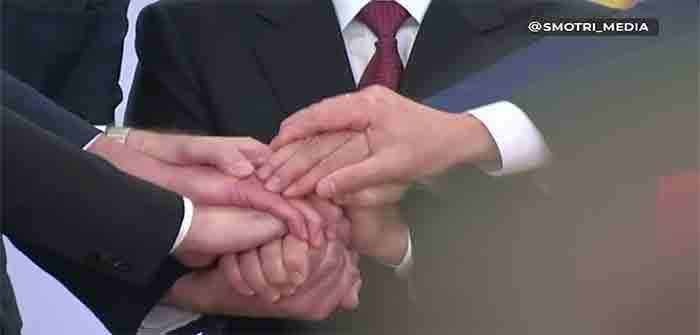
by Bernhard at Moon of Alabama
In 1922 Vladimir Il’ich Lenin, head of the revolutionary Union of Soviet Socialist Republics, decided that several regions which for centuries had been Russian and under Russian rule were to be put, for reasons unknown, under the administration of the Soviet Socialist Republic of Ukraine. In 1954 a similar decision was taken with regards to autonomous republic of Crimea.

bigger
Before 1991 the Ukraine had never existed as a state or independent entity. The early Cossack tribes in the yellow part and green parts of the map had asked for Russian protection against attacks from Poland, Lithuania and other neighbors. In the new Ukraine ethnic Russians were nearly half of the population and the parties they supported managed to win several countrywide elections. Big voting differences were visible along regional/ethnic lines. The country had strong economic relations with Russia. Its industry depended on Russian gas while nearly all its machine and steel exports went to Russia.
The U.S. did not like that. It wanted to control rule the Ukraine to be able to put pressure on Russia. It twice, in 2004 and in 2014, organized ‘color revolutions’ to overthrow elected Ukrainian governments which, for mostly economic reasons, tended to favor relations with Russia.
The 2014 color revolution was exceptionally brutal. The U.S. had organized extreme right wing groups to take the lead in violent protests. (The same groups were in the early 1940s allied with German Nazis and, between 1948 and 1952, were waging a CIA led guerrilla war against the Soviet Union.) The street fighting ended with an unconstitutional change of the government of Ukraine.
The first law that the new coup government implemented was a rejection of Russian as one of Ukraine’s state languages. For some 50% of Ukrainians Russian is their daily language. Ukrainian itself is a Russian dialect. Nearly 100% of Ukrainians understand Russian.
The ethnic Russian people in Ukraine feared being canceled. Crimea, which in 1991 had voted for and declared its independence before the Ukraine did so, voted, under Russian protection, to join Russia. Moscow accepted the move.
People in other former Russian parts of Ukraine protested and a some in the east took up arms. They twice defeated the Ukrainian army and volunteer formations sent against them. The Minsk I and II agreements that followed required Ukraine to give those Donbas oblasts significant autonomy. The United Nations Security Council acknowledged and supported the agreements. But any attempts to implement them were sabotaged by the U.S. via the armed right wing movements that had control over the government in Kiev.
For eight long years the people in the Donetsk and Luhansk People’s Republics defended their borders against constant Ukrainian attempts to solve the conflict by violence. While the people in those republics had voted for the independence of their republics, and to become a part of Russia, the Kremlin did not want to accept that. It wanted that those republics stay within Ukraine and insisted on the implementation of the Minsk agreements.
In 2015 the U.S. and NATO started to build a new Ukrainian army…
Continue Reading